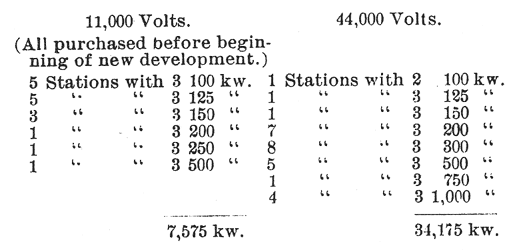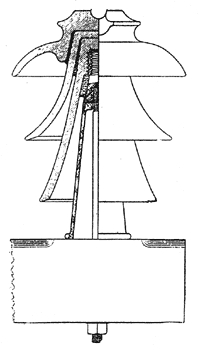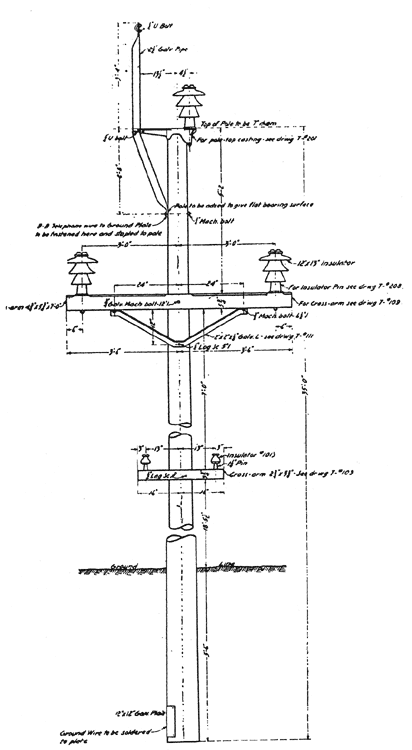[Trade Journal]
Publication: Electrical Review
New York, NY, United States
vol. 53, no. 5, p. 164-165, col. 1-3
SOME ENGINEERING FEATURES OF THE SOUTHERN POWER COMPANY'S SYSTEM.
BY J. W. FRASER.
(Concluded.)
Substations—The first motor installations in cotton mills on this system were of 550 volts, but it was soon seen that the number of small transformer substations, besides complicating operation, would cost excessively, and after some investigation 2,000-volt motors were recommended for all mills converting from steam to electric drive. These installations proved so successful that to-day over one-half the total horse-power in motors is at 2,000 volts. The cost of the conduit in the mills for 2,000 volts is nearly offset by the smaller wire used and this electromotive force permits all mills within a radius of two miles to be fed from one substation. Many new mills, on account of using individual drive and consequently motors below thirty horse-power, are compelled to step-down at least a part of this current to 550 volts.
The sizes of transformers in substations are as follows:
 |
Many of the 44,000-volt substations below 900 kilowatts are now partially or wholly owned by customers, as are also some of the 900-kilowatt and 1,500-kilowatt stations, most of the mills in one town preferring to take shares rather than pay the additional price for power necessary when the station is owned by the power company. The customer usually requests that the power company buy and install the substation apparatus. The customer gets the benefit of any experience which the power company may have and obtains substations at a minimum cost. In the larger towns where attendants must be kept it has been found more satisfactory for the company to own the substation. The power company has discountenanced the buying of transformers below 200 kilowatts on account of the high cost of completed stations per kilowatt. In the case of a 900-kilowatt station (three 300-kilowatt transformers) when the transformer cost is two-thirds of the total and 150 kilowatts cost fifty per cent more per kilowatt than 300-kilowatt transformers, the power company has taken a share in the station rather than have the customer install the small transformers. The companies consider this to be to their interest in view of the facts that they get all new mills and that the interest on the additional investment for two years would not pay the installation charges for substituting the large transformers when they were needed.
All substation transformers have been purchased under a standard specification in order that a few stock transformers which the power company has made it a policy always to keep on hand, may serve as spare apparatus in case of accident.
It is believed that no transformers below 300 kilowatts and very few below 500 kilowatts will have to be purchased in the future, for with the present rapid growth of cotton, mills and the use of 2,200-volt distribution in the towns where substations are located, the small transformers will have to be exchanged for larger ones, the smaller ones being available for the new substations carrying small loads.
It may be of interest to some to know that there are now on our lines 114 50,000-volt fuses of the expulsion type and that they have proved entirely satisfactory.
 |
| Fig. 6. — 44,000-Volt Insulator. |
Secondary Power—From government records and from six years of gaugings before the completion of the Catawba plant, together with two years' operating experience, the flow of the Catawba River had been pretty well determined. The question which presented itself most forcibly was whether to develop the average minimum twelve months' flow, or to develop for ten months, eight months or less, and to supplement with steam power; a problem which has to be determined by the first cost of development and by local market conditions.
Owing to limited library facilities at his command the writer was unable to ascertain if this question had been touched upon elsewhere and how in other cases it had been determined, and so trusts that a few words with reference to this particular case will not be amiss.
 |
| Fig. 7. — Standard Wood Pole. |
In following calculations where the cost of primary and secondary power is taken at a fixed rate, the intention is not to convey the idea that these are actual figures but relative figures which will serve the purpose of this paper.
There are many different solutions to the problem of ascertaining the amount of secondary power which may be economically developed. At one of our developments it was found that the average minimum primary power was in the neighborhood of 16,000 kilowatts and that the increase per month of secondary power was in the neighborhood of twelve and one-half per cent; i. e., 2,000 kilowatts per month. In other words, if secondary power was to be developed for eight months' sale the total development of primary and secondary power would be 24,000 kilowatts. If this secondary power can be sold without an auxiliary steam plant the amount of secondary power which may be developed economically depends only upon whether or not the price received for such power will cover interest and profit on the investment; that is, the investment which is over and above that for developing primary power, but if a steam plant has to be maintained the amount of secondary power to be developed depends also on the cost of steam power. It is very clear that the cost of secondary power is practically the same whether it is sold for eleven months or one month. With this cost, say at $10 per horse-power delivered, steam at $28 per horse-power-year ($6 interest and depreciation, $22 for coal, operating expenses, etc.), if interest and depreciation on the steam plant is entirely chargeable to the months when steam plant is in operation, then
Cost of steam power per month = 1.83 + 6/x
When x = the number of months in operation.
Amount of secondary power to be developed 16,000 kilowatts X 12.5x/100 = 2,000x
Cost of steam-secondary
=2,000x (1.83 + 6/x) x 2,000x X 10
= 2,000 (1.83x2 + 6x + 10x)
If power is selling at $20, profit
= (2,000x 20 — {2,000 (1.83x2 + 16x)}
= 2,000 (20x — 1.83x2 — 16x)
(For max.) dy/dx = 3.66x — 4
x = 1.1 month
On this basis maximum profit would be made on 2,200 kilowatts secondary development.
A more practical method under existing conditions seems to be to charge the interest and depreciation of steam plant to the operating expenses of the system, inasmuch as the steam plant is an insurance against a partial shut-down and makes spare units unnecessary, and in the case of steam turbines, when run as synchronous motors, saves copper because it brings up the power-factor. The above equation now becomes:
Cost of steam + secondary
= 2,000x (1.83x) + 2,000x X 10)
= 2,000 (1.83x2 + 10x)
Profit
= 2,000 X 20 - (2,000 (1.83x2 + 10x)
=2,000 (20x - 1.83x - 10x)
= 2,000 (10x - 1.83x2)
(For Max.) dy/dx = 3.66x - 10
x = 2 - ¾
Maximum profit on this basis would be made on 5,500 kilowatts (35 per cent) secondary development.
Had $24.50 been taken as the selling price of power x would equal four months, or the total development should be made for 150 per cent of mean average low water. Although power from hydroelectric plants has been selling in the Carolinas for less than this latter figure there is no doubt that reliable service demands this price.
There is another argument in favor of developing for 150 per cent mean average low water. If it costs only one-half as much to develop secondary power as primary, twice the loss can be allowed on transmission lines; or, in other words, one and one-half times the power can be transmitted during secondary power seasons. Now, if the transmission lines are figured for an economical loss when transmitting primary power only, secondary power to the extent of fifty per cent of the primary power can be developed without additional copper. This only holds good when the auxiliary steam plants can be built in the neighborhood of distribution centres whose consumption of power is equal to the amount of secondary power.
Many mills which had steam plants already installed made contracts for secondary power for eight months in the year, but after a few months' operation by electric drive their owners found the production so much increased and their labor and other troubles so much lessened that many of them desired to change their contracts to primary power. The result of this is that the plans for a supplementary steam plant are now in course of preparation. The initial installation will be 15,000 kilowatts and will be located at Spartanburg, S. C., near the southern end of the system, sixty-four miles from the main switching station at Great Falls on the 88,000-volt line. The ultimate installation is expected to reach 40,000 kilowatts, divided between this point and some point near the eastern end of the system. It is thought better to divide the plant for safety and in order that the line loss may be kept as low as possible.
